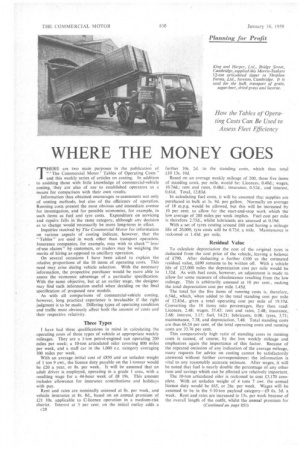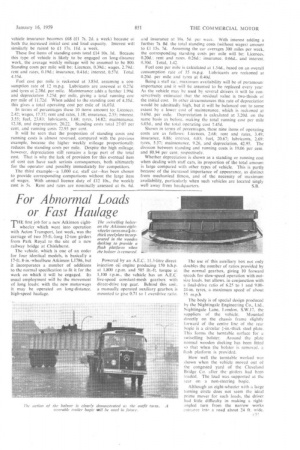WHERE THE MONEY GOES
Page 64

Page 67

If you've noticed an error in this article please click here to report it so we can fix it.
THERE are two main purposes in the publication of The Commercial Motor' Tables of Operating Costs" and this weekly series of articles on costing. In addition to assisting those with little knowledge of commercial-vehicle costing, they are also of use to established operators as a means for comparison with their own results,
Information thus obtained encourages re-assessment not only of costing methods, but also of the efficiency of operation. Running costs present the most obvious and immediate avenue for investigation, and for possible economies, for example, in such items as fuel and tyre costs. Expenditure on servicing and repairs falls in the same category, although any decision as to change would necessarily be more long-term in effect.
Inquiries received by The Commercial Motor for information on various aspects of costing indicate, however, that the "Tables" are used in work other than transport operation. Insurance companies, for example, may wish to check' loss: of-use claims" by customers, or traders may be weighing the merits of hiring as opposed to ancillary operation. .
On several occasions I have been asked to explain the relative_ proportions of the 10 items of operating costs. This need may arise during vehicle selection. With the necessary information, the propective purchaser would be more able to assess the economic advantage of a particular specification. With the same objective, but at an earlier stage, the designer may find such information useful when'deciding on the final specification of proposed new models.
As with all comparisons of commercial-vehicle costing, however, long practical experience is invaluable if the right judgment is to be made. Differing types of operating condition and traffic must obviously affect both the amount of costs and their respective relativity. .
Three Types
I have had these qualifications in mind in calculating the operating costs of three types of vehicle at appropriate weekly mileages, They are a 1-ton petrol-engined van operating 200 mites per week; a 10-ton articulated oiler covering 800 miles per week, and a staff car in the 1,000 c.c. category averaging 300 miles per week.
With an average initial cost of £850 and an unladen weight of 1 ton 9 cwt., the licence duty payable on the 1-tonner would be £20 a year, or 8s. per week. It will be assumed that an adult driver is employed, operating in a grade 1 area, with a resulting wage for a 44-hour week of £8 19s. This amount includes allowance for insurance contributions and holidays with pay.
Rent and rates are nominally assessed at 8s, per week, and vehicle insurance at 8s. 8i1, based on an annual premium of £21 10s. applicable to C-licence operation in a medium-risk district. Interest at 3 per cent, on the initial outlay adds a c28 further 10s. 2d. to the standing costs, which thus total £10 13s. 10d.
Based on an average weekly mileage of 200, these five items of standing costs, per mile, would be: Licences, 0.48d.; wages, 10.74d.: rent and rates, 0.48d.: insurance, 0.52d., and interest, 0.61d. Total, 12.83d.
. In calculating fuel costs, it will be assumed that supplies are purchased in bulk at 3s. 9d. per gallon. Normally an average of 18 m.p.g. would be allowed, but this will be increased by 10 per cent, to allow for the start-and-stop work which the low average of 200 miles.per week implies. Fuel cost per mile is therefore 2.75d., whilst lubricants are assessed at 0.19d.
With a set of tyres costing around £60 and having a mileage life of 20,000, tyre costs will be 0.72d. a mile. Maintenance is reckoned at 1.43d. per mile.
Residual Value
To calculate depreciation the cost of the original tyres is deducted from the cost price of the vehicle,, leaving a balance of £790. After deducting a further £100 as the estimated residual value, £690 remains to be written off, With a vehicle life of 125,000 miles the depreciation cost per mile would be 1.32d. As with fuel costs, however, an adjustment is made to allow for some measure of obsolescence resulting from the low mileage. This is arbitrarily assessed at 10 per cent, making the total depreciation cost per mile I.45d.
The total for the five items of running costs is, therefore, 6.54d., which, when added to the total standing cost per mile of 12.83d., gives a total operating cost per mile of 19.37d. Converting the 10 items into percentages, they then read: Licences, 2.48: wages, 55.45; rent and rates. 2.48; insurance, 2.68; interest, 3.15; fuel, 14.21; lubricants, 0,98; tyres, 3.71; maintenance, 7.38, and depreciation, 7.48. Total standing costs are thus 66.24 per cent, of the total operating costs and running costs are 33.76 per cent.
This comparatively high ratio of standing costs to running costs is caused. of course, by the low weekly mileage and emphasizes again the importance of this factor. Because of the repeated omission of any indication of the average mileage, many requests for advice on costing cannot be satisfactorily answered without further correspondence: the information is vital to any reasonably accurate estimate. After wages, it will be noted that fuel is nearly double the percentage of any other item and savings which can be effected are relatively important.
The 10-ton articulated oiler is reckoned to .cost £3,170 complete. With an unladen weight of 4 tons 7 cwt. the -annual licence duty would be £65, or 26s. per week. Wages will be assumed to be in the 5-10-ton payload category-19 6s. 3d. a week. Rent and rates are increased to 13s. per week because of the overall length of the outfit, whilst the annual premium for
vehicle insurance becomes £68 al 7s. 2d. a week) because ol both the, increased initial cost and load capacity. Interest will similarly be raised to £1 17s. Ild, a week.
These live items of standing costs total £14 10s, Id. Because this type of vehicle is likely to be engaged on long-distance work, the average weekly mileage will be assumed to be 800. Standing costs per mile will be: Licences, 0.39d.; wages, 2.79d.; rent and rates, 0.19d.; insurance, 0.41d.; interest, 0.57d. Total. 4.35d.
Fuel cost pet mile is reckoned at 3.83d. assuming a consumption rate of 12 m.p.g. Lubricants are assessed at 0.27d. and tyres at 2.38d. per mile_ Maintenance adds a further 1.99d• and depreciation 3.25d, per mile, giving a total running cosi per mile of 11.72d. When added to the standing cost of 4.35d.. this gives a total operating cost per mile of 16.07d.
In terms of percentages these 10 items amount to: Licences. 2.42; wages, 17.37; rent and rates, 1.18; insurance, 2.55; interest 3.55; Wel, 23.83; lubricants, 1.68; tyres, 14.82; maintenance. 12.38, and depreciation, 20,22. Standing costs total 27.07 per
• cent, and running costs 72.93 per cent.
It will be seen that the proportion of standing costs and running costs is almost reversed, compared with the previous example, because the higher weekly mileage proportionally reduces the standing costs per mile, Despite the high mileage. however, depreciation still remains a large part of the total cost. That is why the lack of provision for this eventual item of cost can have such serimis consequences, both ultimately for the operator and possibly immediately for competitors.
The third example—a 1,000 c.c. staff car—has been chosen to provide corresponding comparisons without the large item of wages. With annual licence duty of £12 10s., the weekly cost is 5s. Rent and rates are nominally assessed at 6s. 6d. and insurance at 16s. 5d. per week. With interest adding a further 7s. 8d. the total standing costs (without wages) amount to £.1 15s. 7d. Assuming the car averages 300 miles per week, the corresponding standing costs per mile will be: Licences, 0.20d.: rent and rates, 0.26d : insurance, 0.66d.. and interest, 0.30d. Total, 1.42.
Fuel cost per mile is calculated at I.54d., based on an overall consumption rate of 35 m.p.g. Lubricants are reckoned at 0.20d. per mile and tyres at 0.40d.
Being a staff car. maximum availability will be of paramoun: importance and it will be assumed to be replaced every year As the vehicle may be used by several drivers it will be conservatively estimated that the residual value is two-thirds of the initial cost. In other circumstances this rate of depreciation would be admittedly high, but it will be balanced out to some extent by a lower cost of maintenance, which is reckoned at 0.69d. per mile. Depreciation is calculated at 3.20d. on the same basis as before, making the total running cost per mile 6.03d., and the total operating cost 7.45d.
Shown in terms of percentages, these nine items of operating costs are as follows: Licences, 2.68: rent and rates, 3.49; insurance, 8.86; interest, 4.03; fuel, 20.67; lubricants, 2.69: tyres, 5.37; maintenance, 9.26, and depreciation, 42.95. The division between standing and running costs is 19.06 per .cent and 80.94 per cent. respectively.
Whether depreciation is shown as a standing or running cost when dealing with staff cars, its proportion of the total amount is large compared with other types of vehicle. This is partly because of the increased importance of appearance, as distinct from mechanical fitness, and of the necessity of maximum availability, particularly when such vehicles are located singly well away from headquarters. S.B.








































































































